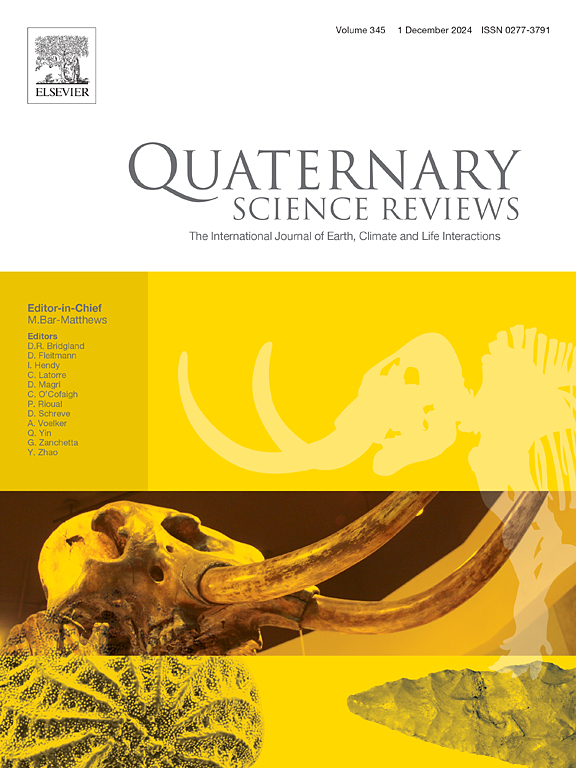古罗马高卢(法国维埃纳)生产水管用铅矿的来源
IF 3.2
1区 地球科学
Q1 GEOGRAPHY, PHYSICAL
引用次数: 0
摘要
罗马城市的城市结构通过安装主要由铅(Pb)制成的供水网络而发展。在高卢,维埃纳城(法国)是制造铅制品的中心,包括大量的铅水管。虽然铅制品经常被贴上罗马时期的邮票,表明制造地点,但我们对提取的铅矿石的来源和进口方式的了解仍然有限。在这项研究中,对罗马时期的文物进行了Pb同位素特征分析,以记录维埃纳工厂使用的铅矿石的来源。利用新算法将铅同位素特征与新的本地Pb矿石数据和更新的Pb同位素数据库进行比较,确定Pb的来源。结果表明,用于维埃纳手工制品制造的铅主要来自单一来源。用新算法处理的数据确定了莱茵地块和Pennines矿区是主要和最可能的来源,但一些人工制品显示出与当地铅矿相似的同位素组成。在维也纳发现的器物的铅同位素特征与来自莱茵地块的美因茨管道和铅锭的铅同位素特征的相似性,以及该地区采矿时期的同步性,支持了莱茵地块是维也纳最有可能的铅来源。最后,我们提出在罗马时期,莱茵河和索恩河是最有可能运输铅到维也纳的路线。本文章由计算机程序翻译,如有差异,请以英文原文为准。
Provenance of lead ores used for water pipes production in the ancient Roman Gaul (Vienne, France)
The urban fabric of Roman cities developed through the installation of water supply networks, mainly made of lead (Pb). In Gaul, the city of Vienne (France) was central to the manufacturing of Pb artifacts, including large volumes of Pb water pipes. Although Pb artifacts were often labeled with Roman-period stamps indicating the location of manufacturing, our knowledge of the provenance of extracted Pb ore and the way they were imported remains limited. In this study, Roman-period artifacts were analyzed for Pb isotope signatures to document the source of Pb ore used in Vienne's manufactories. Lead isotope signatures were then compared with new local Pb ores data and an updated Pb isotope database using a new algorithm to identify the provenance of Pb. Results indicate that Pb used for artifact manufacturing at Vienne originates mainly from a single source. Data treatment with the new algorithm identifies the Rhenish Massif and the Pennines mining regions as the primary and most probable source, but some artifacts exhibit a similar isotope composition to that of local Pb ores. The similarity of the Pb isotopic signatures of the artifacts produced in Vienne with those of Mainz pipes and lead ingots from the Rhenish massif, as well as the synchronicity of the mining periods in this region, support the Rhenish Massif as the most likely source of Pb for Vienne. Finally, we propose the Rhine and Saone Rivers as the most probable Pb ores conveyance routes to Vienne during the Roman Period.
求助全文
通过发布文献求助,成功后即可免费获取论文全文。
去求助
来源期刊

Quaternary Science Reviews
地学-地球科学综合
CiteScore
7.50
自引率
15.00%
发文量
388
审稿时长
3 months
期刊介绍:
Quaternary Science Reviews caters for all aspects of Quaternary science, and includes, for example, geology, geomorphology, geography, archaeology, soil science, palaeobotany, palaeontology, palaeoclimatology and the full range of applicable dating methods. The dividing line between what constitutes the review paper and one which contains new original data is not easy to establish, so QSR also publishes papers with new data especially if these perform a review function. All the Quaternary sciences are changing rapidly and subject to re-evaluation as the pace of discovery quickens; thus the diverse but comprehensive role of Quaternary Science Reviews keeps readers abreast of the wider issues relating to new developments in the field.
 求助内容:
求助内容: 应助结果提醒方式:
应助结果提醒方式:


